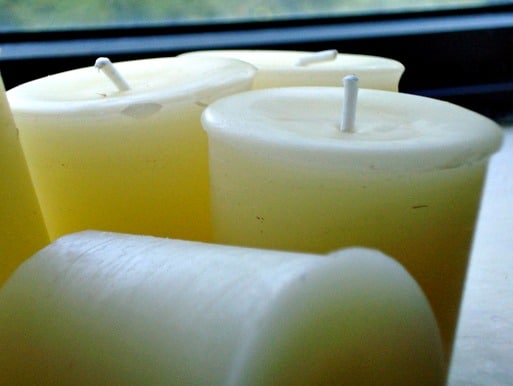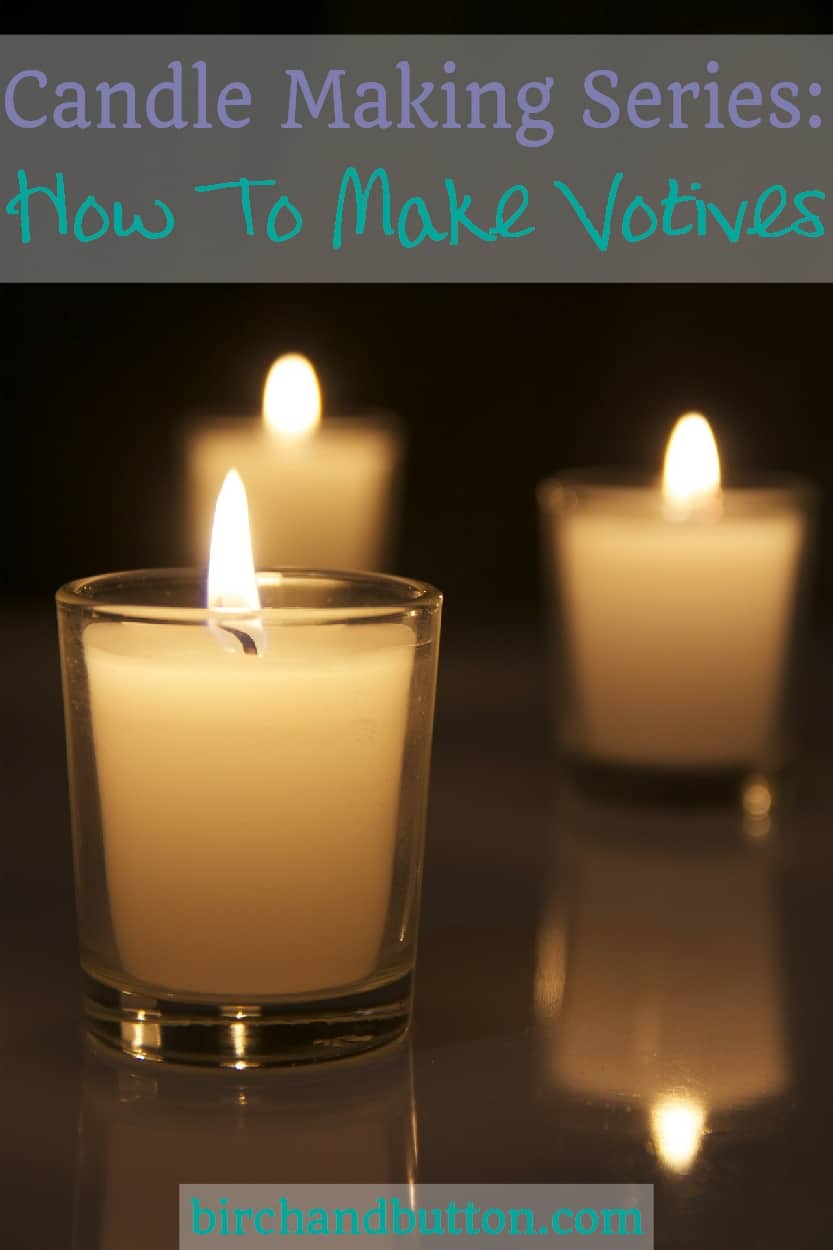Welcome to the fourth post in my Candle Making Series. In the first post we looked at the items that make great candle containers, which is great for getting creative and upcycling, then in the second post I talked about how to make container candles. Last time I described the method for making pillar candles.
This time we’re going to be looking at making votives. I like them because they are actually great value for money, especially when made with soy pillar blend wax, as they can burn for around 15 hours in total. They’re great mantlepiece candles, especially in odd numbers (I don’t know why, it’s just my preference – three is the ideal number I think!).
In the method below, I use auto wick pins. These are little metal rods on a metal base which slot into the votive mould before the wax has been poured. When the candle is fully set, after 24 hours, the pin can be removed and a wick put in its place. What these pins do is ensure the wick is perfectly central, and using them removes the process of adding the wick when the candle is beginning to set. Using auto wick pins is completely a matter of preference, but I find it easier. If you choose not to use them, just pour the wax into the empty mould. Then, when the candle has developed a “skin” but isn’t completely set, gently insert a prepared wick into the mould by breaking the surface of the wax with the edge of the sustainer and placing it as centrally as possible. Then allow the votive to set as per the rest of the instructions.
I won’t lie to you and say you’ll get perfect votives first time – they definitely take practise to get right, and I still find it difficult to get perfect results each time. It’s not impossible but it does take patience, and an understanding of how temperamental setting wax can be! The temperature and humidity of the room can make a huge difference, as can the temperature of the mould. The average room temperature (which is what? Around 18°C?) is fine, but keep setting candles out of the sun or a draught, no matter how subtle it may seem to you! As crazy as it may seem, I’ve found it easier to regulate room temperature in the winter, when it’s likely that the windows are closed and the heating is on at a constant temperature. I find that in the summer, the kitchen is cooler in the morning and much warmer in the afternoon when the sun comes round to that side of the house, so it’s worth bearing this stuff in mind for the best chance at achieving consistent results.
I hope I haven’t put you off saying all that, but I want you to realise that it’s normal to end up with slightly odd shaped votives when you’re getting used to making them. It can be frustrating, but don’t give up! Keep the practice runs for yourself – after all, they’ll still smell beautiful even if they’re not quite the right shape – and save the perfect ones for presents!
SAFETY NOTES
- Never leave melting wax unattended.
- Hot wax can burn, so this isn’t an activity for children, and keep pets well away.
- Cover your work area and clothing to protect against any spillages.
- Never overheat wax; it doesn’t boil to signify that it is too hot, it will just catch fire.
- In the unlikely event of a fire, DO NOT try to dowse with water but cover the fire with a damp cloth or a fire blanket.
SUPPLIES NEEDED
- Votive moulds
- Auto wick pins
- Vegetable oil or mould release spray
- Pillar blend wax (70g per mould)
- Dye (optional)
- Fragrance (optional) (3.5g per votive)
- Votive wicks with sustainers

MELTING THE WAX
Melt the soy wax in a double boiler or a bowl over a pan of water. DO NOT melt the wax in a pan directly on the cooker as this is a fire hazard. For the best possible result, you should use a thermometer to check the temperature of the wax when you are melting it. It should reach somewhere in the range of 70-75°C if you’re adding dye and scent. If you’re not adding any colour or scent, you can pour the wax when it has just melted.
PREPARING THE MOULD
Wipe the inside of the moulds and the auto wick pins with the oil or mould release spray and then place the pins into the moulds. Stand the moulds on a piece of cling-film in a tray – it’s very difficult to fill a votive mould without spilling any wax at all, but you can peel any spillages off the cling-film when it has set and reuse it.
ADDING THE DYE
You now need to add the dye to the wax, if you’re using it. The colour of the molten wax will be more intense than the colour when it sets, so bear than in mind when adding the dye. If in doubt, allow a little of the coloured wax to set on a white plate or something similar so that you can see the colour the finished candle will be. Bear in mind that you can add more dye but you can’t take it away! Ensure the wax is in the range of 70-75°C before you add the dye, and then stir it well to thoroughly incorporate. Take the wax off the heat and pour it into a jug if it’s not in one already – this will make the final pour a lot less messy.
ADDING THE FRAGRANCE
The fragrance goes into the molten wax next, if you’re using it. You will need to use 3.5g fragrance per votive (so if you’re making 6 votives, for example, you will need 3.5 x 6 = 21g fragrance oil). Remove the wax from the heat if you haven’t already and stir the scent in well to make sure it is properly combined with the wax and to avoid pools of fragrance in the finished candle. Adding the fragrance oil will bring the temperature down so make sure you are ready to pour after stirring this in.
POURING THE WAX
The ideal pouring temperature for the wax is 65°C, so if adding the dye and scent hasn’t brought it down to this temperature, wait until it is. Pour the wax slowly into the mould, right up to the top so your votives have the lip you’re probably used to seeing. (At this point you will find out just how useful that cling-film is!) You will almost certainly need to top up the votives as the wax has a tendency to sink around the wick pin, and this can take some practise to get spot-on. Allow 10-15 minutes for the wax to begin setting and then test it with a skewer. When the wax has partially set, so that it’s set around the edges but still molten under the surface in the centre, poke a few holes around the wick and pour more wax. You’ll probably need to remelt the wax to do this, but only melt it until it is liquid enough to pour. You don’t want to bring the temperature up too high or you’ll burn off the fragrance oil. You may need to repeat this process of topping up the candle but it’s important that you only top up the dip in the centre and don’t go past the original pour line or you may find your candle sticks to the mould.
DEMOULDING YOUR VOTIVES
Leave the candles to cool and set completely. For best results, they should be out of any draughts and not in a cold place. Don’t put the candle in the fridge to speed up the setting process as the wax will crack. After 24 hours you should be able to lift the votives out of the mould and then gently tap the wick pin out from the centre. Don’t rush this process, as you can take the bottom off the votive. If the pin doesn’t come out easily, put the votive in the fridge for half an hour and it should be fine. Push a wick through the hole in the centre until the sustainer embeds into the bottom of the candle. Clean your moulds thoroughly in preparation for the next use.
BURNING YOUR CANDLE
Before lighting, trim the wick so it is no more than 0.5cm long and place the votive in a votive container. Then you’re ready to enjoy your homemade candle!
It may seem like common sense, but there are a few rules to follow when burning candles to ensure you and those around you can enjoy your candle safely:
- Never leave a burning candle unattended.
- Keep a lit candle away from draughts and vibrations.
- Keep the candle out of reach of children and pets.
- Never burn your candle on or near anything that can catch fire.
- Trim wick to 5mm before lighting to prevent smoking or flickering flame.
- Keep candle free of any foreign materials, including matches and wick trimmings.
- Only burn the candle on a level, fire resistant surface.
- Do not burn the candle for more than 4 hours at a time.
- Never use a chipped or cracked container as it may shatter.
(Source of title photo: Flickr)

